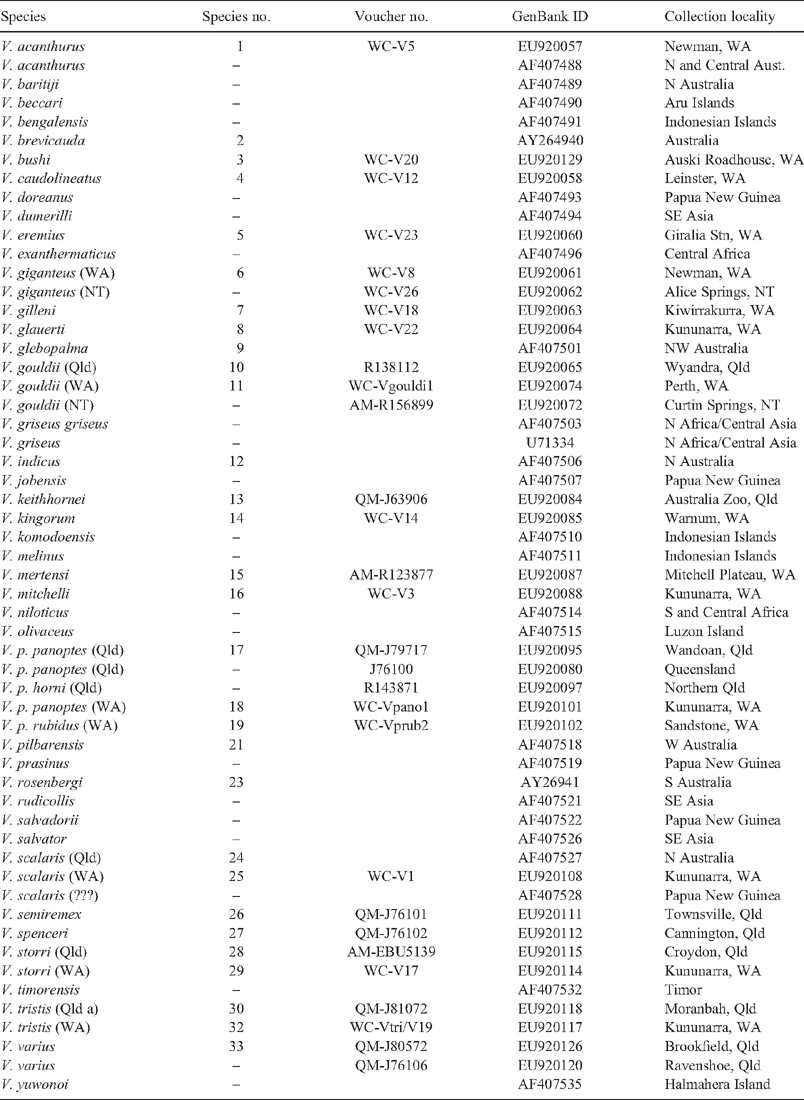Is body shape of varanid lizards linked with retreat choice?
Graham G. Thompson A F , Christofer J. Clemente B , Philip C. Withers C , Bryan G. Fry D and Janette A. Norman EA Centre for Ecosystem Management, Edith Cowan University, 100 Joondalup Drive, Joondalup, WA 6027, Australia.
B Department of Zoology, University of Cambridge, Downing Street, Cambridge CB2 3EJ, UK.
C Zoology, School of Animal Biology (M092), University of Western Australia, Crawley, WA 6009, Australia.
D Department of Biochemistry, Bio21 Institute, University of Melbourne, Vic. 3010, Australia.
E Population and Evolutionary Genetics Unit, Sciences Department, Museum Victoria, GPO Box 666, Melbourne, Vic. 3001, Australia.
F Corresponding author. Email: g.thompson@ecu.edu.au
Australian Journal of Zoology 56(5) 351-362 https://doi.org/10.1071/ZO08030
Submitted: 18 March 2008 Accepted: 14 January 2009 Published: 3 March 2009
Abstract
In our earlier analysis of Varanus body shape, size was a dominating factor with some qualitative phylogenetic patterns and grouping of species into ecological categories. With a phylogeny and an improved capacity to account for the effects of size, we have reanalysed our morphometric data for male Australian goannas (Varanus spp.) using an increased number of specimens and species to examine whether variations in body shape can be accounted for by retreat choice, as it can for Western Australian Ctenophorus dragon lizards. After accounting for body size in the current analysis, four ecotypes based on retreat choice (i.e. those that retreat to oblique crevices between large rocks or rock faces, those that retreat to burrows dug into the ground, those that retreat to spaces under rocks or in tree hollows, and those that retreat to trees but not tree hollows) accounted for much of the variation in body shape. There is a phylogenetic pattern to the ecotypes, but accounting for phylogenetic effects did not weaken the link between body shape and ecotype based on retreat choice. This suggests that there are large differences in body shape among ecotypes, and shape is relatively independent of phylogeny. The strong link between shape and choice of retreat site in Varanus spp. is consistent with that for Ctenophorus spp. We speculate on why there might be a strong link between retreat choice and body shape for both Varanus and Ctenophorus.
Arnold, S. J. (1983). Morphology, performance and fitness. Integrative and Comparative Biology 23, 347–361.
| Crossref | GoogleScholarGoogle Scholar |
Card, W. , and Kluge, A. G. (1995). Hemipeneal skeleton and varanid lizard systematics. Journal of Herpetology 29, 275–280.
| Crossref | GoogleScholarGoogle Scholar |
Filatov, D. A. (2002). Analysis of DNA sequence data sets. Molecular Ecology Notes 2, 621–624.
| Crossref | GoogleScholarGoogle Scholar | CAS |
Harmon, L. J. , Kolbe, J. J. , Cheverud, J. M. , and Losos, J. B. (2005). Convergence and the multidimensional niche. Evolution 59, 409–421.
| PubMed |
Irschick, D. J. , and Garland, T. (2001). Integrating function and ecology in studies of adaptation: investigations of locomotor capacity as a model system. Annual Review of Ecology and Systematics 32, 367–396.
| Crossref | GoogleScholarGoogle Scholar |
Jusufi, A. , Goldman, D. I. , and Revzen, S. (2008). Active tails enhance arboreal acrobatics in geckos. Proceedings of the National Academy of Sciences of the United States of America 105, 4215–4219.
| Crossref | GoogleScholarGoogle Scholar | CAS | PubMed |
Kohlsdorf, T. , Garland, T. , and Navas, C. A. (2001). Limb and tail lengths in relation to substrate usage in Tropidurus lizards. Journal of Morphology 248, 151–164.
| Crossref | GoogleScholarGoogle Scholar | CAS | PubMed |
Losos, J. B. (1990a). Ecomorphology, performance capability and scaling of West Indian Anolis lizards: an evolutionary analysis. Ecological Monographs 60, 369–388.
| Crossref | GoogleScholarGoogle Scholar |
Melville, J. , and Swain, R. (2000). Evolutionary relationships between morphology, performance and habitat openness in the lizard genus Niveoscincus (Scincidae: Lygosominae). Biological Journal of the Linnean Society 70, 667–683.
Mosimann, J. E. (1970). Size allometry: size and shape variables with characterizations of the lognormal and generalised gamma distributions. Journal of the American Statistical Association 65, 930–945.
| Crossref | GoogleScholarGoogle Scholar |
Posada, D. , and Crandall, K. A. (1998). MODELTEST: testing the model of DNA substitution. Bioinformatics 14, 817–818.
| Crossref | GoogleScholarGoogle Scholar | CAS | PubMed |
Somers, K. M. (1986). Multivariate allometry and removal of size with principal components analysis. Systematic Zoology 35, 359–368.
| Crossref | GoogleScholarGoogle Scholar |
Thompson, G. G. (1994). Activity area during the breeding season of Varanus gouldii (Reptilia: Varanidae) in an urban environment. Wildlife Research 21, 633–641.
| Crossref | GoogleScholarGoogle Scholar |
Thompson, G. G. , and Withers, P. C. (1997). Comparative morphology of Western Australian varanid lizards (Squamata: Varanidae). Journal of Morphology 233, 127–152.
| Crossref | GoogleScholarGoogle Scholar |

|


